Blackburn Scorch light review
We here at Slowtwitch like riding with lights. Day or night – rain or shine. The benefits for night riding are obvious. During the day, a bright light can improve your visibility to automobile drivers. This same logic, for example, is the reason that many new cars feature daytime running lights that remain on whenever the vehicle’s engine is running.
For cycling, how bright is bright enough? That remains a question. The most popular modern unit of measurement for this is the venerable lumen. In the past, some companies published candlepower or wattage for their lights, which leave many more question marks than lumens (in terms of what it actually means to the human eye). Wikipedia defines the lumen as “the SI derived unit of luminous flux, a measure of the total "amount" of visible light emitted by a source.” In layman’s terms – it’s how much light is produced that is actually useful to us. More lumens mean more visibility of the road ahead of you, and more visibility to drivers.
From speaking with many industry friends and manufacturers, I’ve found that the generally accepted minimum for a “bright” light is about 140 lumens. This is definitely brighter than your run-of-the-mill mini blinking light powered by two AA batteries. Most lights with 140-or-more lumens rely on a rechargeable lithium ion battery. In the past, this also usually meant that you were signing yourself up for an external battery pack – one that is separate from the light itself. While this design works well and tends to offer a long run time, they can be cumbersome to attach to your bike or helmet.
That in mind, I was quite excited when Blackburn offered to send their completely self-contained, 140 lumen Scorch to me.
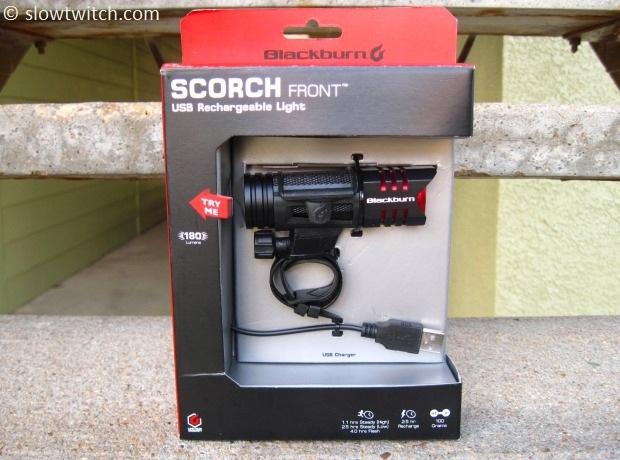
The specs are attractive on-paper. The US retail price is a very-affordable $70. It offers 1 hour of output on ‘high’, 3 hours on ‘low’, and 5 hours on ‘flash’ (I personally timed the light in ‘high’ mode – it lasted one hour and seven minutes). There is a handy USB charger that can easily fit in a jersey pocket. If you commute to work on your bike, just bring the charger with you and charge the light at your desktop computer.
Note that this light is intended for handlebar-use only (the mount is adjustable for different size handlebars). Blackburn does not make a helmet mount for it. Here is the Scorch mounted to my 31.8mm diameter mountain bike handlebar:
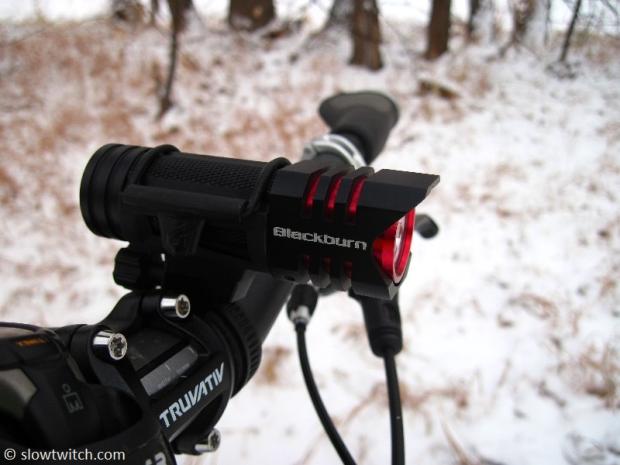
I’ve also used this light mounted to an aerobar via a Profile-Design Universal Computer Mount. An alternate option is to make your own 31.8mm aerobar mount from PVC pipe (the instructions for which are linked at the bottom of this article).
The mount itself feels to be fairly sturdy. I had no trouble with it moving around over rough pavement or trails. The nice part is that the light gets held in the cradle via an easy rubber band system:
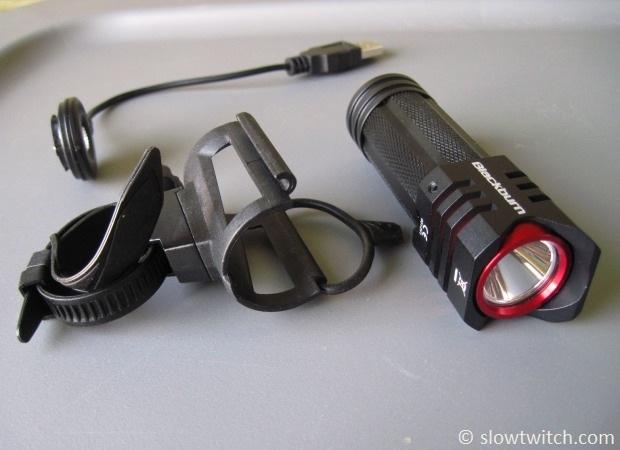
The light gets held firmly in place, yet is still easy to remove for charging.
Speaking of charging, the quoted maximum charge time is 2.5 hours. The USB cable attaches with a magnetic disc to the back of the light. You press the two halves together, and rotate the light about 1/8th turn until it locks in to place.
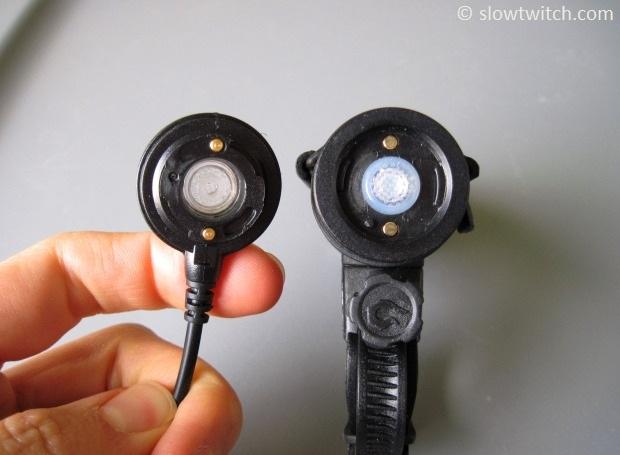
The charger was the only part of the light that disappointed me. The cable itself works fine. The problem came when I plugged it in to my laptop computer. Most of the time, it worked great; the light charged normally. However, on one occasion, I plugged the light in, and my computer immediately crashed. I thought it was just a strange coincidence of time (i.e. the two events just happened to occur simultaneously). I kept using the light, and didn’t think much about it. However, about two weeks later, the same thing happened. Plug the charger in to the laptop – computer crashes. Note, I’ve charged a host of various Garmins, iPods, and other electronics in a similar fashion without issue. I inquired with Blackburn about it, but as of this writing they’ve yet to find an explanation for the strange behavior.
They did mention, however, that you can just as easily use a USB-to-wall-outlet adapter. Most of us have at least one of these things from our iPhones, iPads, and similar devices.
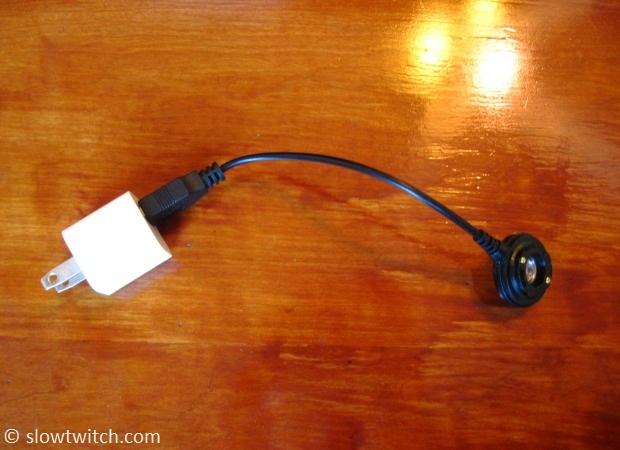
Using the USB-to-wall adapter, I’ve had no problems. As a bonus, the charging time seems to be much quicker, too. I’m fine using this type of converter, but as a consumer, I’d expect that Blackburn include one with each Scorch light that goes out the door.
Testing
So, how bright is this thing? Oddly enough, the Blackburn website quotes 140 lumens, but the product package quotes 180. I’m not sure which is correct. I happened to have a few lights handy, and decided to do a simple comparison test.
The Scorch relies on a single bright LED bulb:
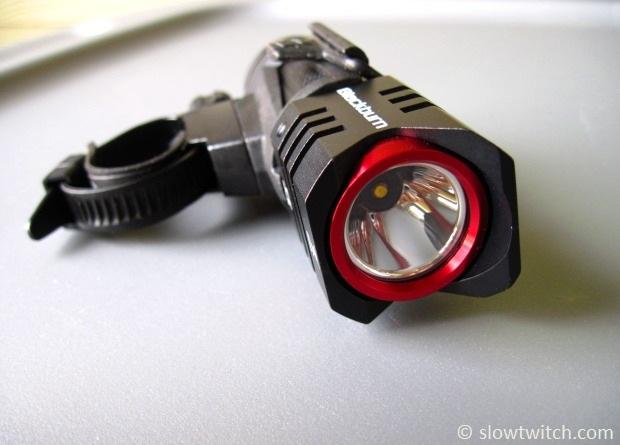
Only five or ten years ago, most bicycle lights had HID, or High Intensity Discharge bulbs. These are generally bulkier than LED, but do the job. They also take longer to power up – say, 30 seconds to achieve full brightness.
My first comparison was with a Light and Motion Arc. I bought this light about 7 or 8 years ago; at the time is was one of the brighter choices on the market. In the max output mode, it achieves a claimed 675 lumens for three hours. In my experience, it is very bright, but only runs for about 2.5 hours in high mode.
Side-by-side, you can see that the two lights are quite different. This is certainly not an apples-to-apples comparison, but I had to use the lights I had on hand (and was honestly just curious to compare the two, being so different in size and weight). The Scorch is on the left; the Light and Motion on the right:
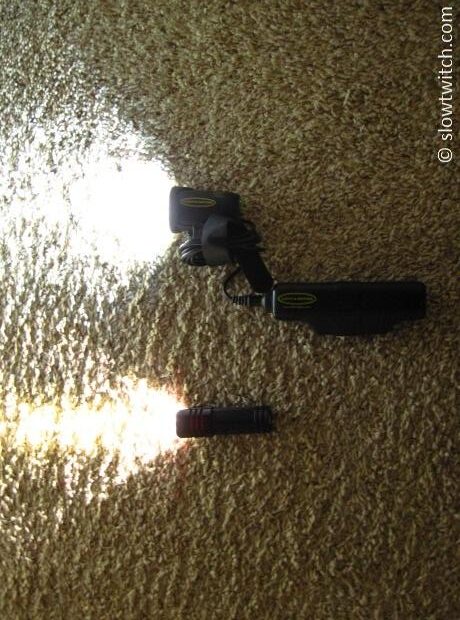
The Light and Motion battery alone weighs four or five times what the complete Scorch does. In terms of brightness, they performed about as-expected. The Light and Motion’s HID bulb puts out a whiter light, brighter center, and large spread:
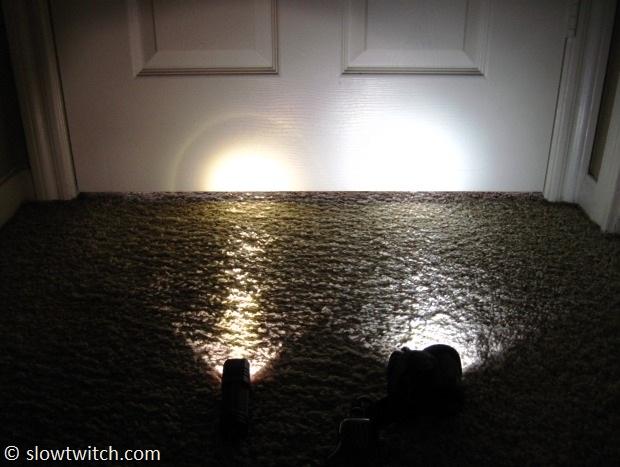
The Light and Motion is definitely brighter, but you pay the price in weight and complexity.
Note that I hesitated to do any photography of the lights in-action. Every online light review tries to do it, and it’s almost impossible to truly get an accurate representation of what the eye sees. In this case, you’ll just have to trust me. The process went like this: 1) Shoot photo, 2) Upload to computer, 3) Fiddle with light settings in editing software, and 4) Repeat. I went through this procedure a lot until I felt that the photos were reasonably accurate and “real”.
For a better comparison, I pitted the Scorch against my tried-and-true DiNotte 140l. The DiNotte has an external battery pack (and longer run time), but the two should theoretically have the same brightness. The Scorch is on the left; DiNotte 140l on the right:
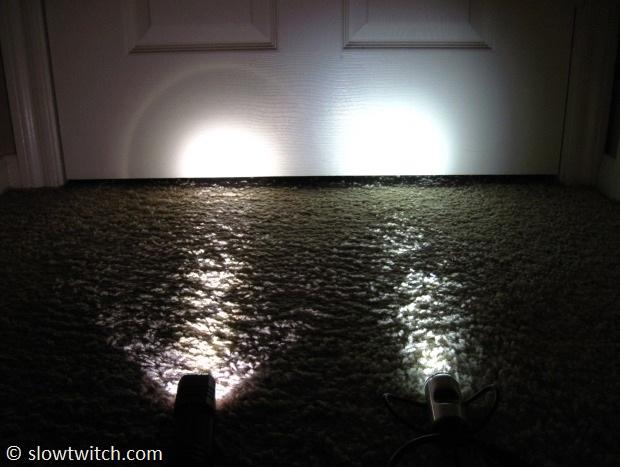
As you can see, the DiNotte has a whiter light than the Scorch, but I don’t know if that matters in terms of visibility. In overall brightness, I give the edge to DiNotte.
The center beam for both lights focus in a fairly small area. Compare this to the Light and Motion above, and you see that the real difference is in total light dispersion. The Light and Motion had the brightest center AND the greatest area. A greater area of illumination is beneficial for night riding on trails, where you want to see obstacles on the edge of the trail, such as tree branches.
Conclusion
Who is the customer for the Blackburn Scorch? Is it bright enough? What else should I be considering?
The Scorch is certainly much brighter than the cheap ten dollar plastic ‘safety light’. However, I don’t think that it is quite bright enough for road riding at dawn or dusk in high traffic areas, when you need really bright lights to be seen through sun glare (i.e. 600, 700, 800+ lumens). I see the Scorch as a very good supplemental light for someone who already has a bright helmet light, and wants to add a little more. Perhaps you want to use the helmet light in steady mode for general illumination, and use a Scorch on your handlebar in flashing mode to attract extra attention (or vice versa). The run time won’t get you through a 24 hour race, but with 5 hours in flashing mode, it will get many of us through most or all of our training rides.
Alternatively, for those on a tight budget, the Scorch is a good starter light. Blackburn supports their products with a lifetime warranty, so you’re guaranteed a safe investment. I’ve actually found myself using it often as a flashlight around the house – it avoids wasting disposable batteries in standard flashlights, and is MUCH brighter to boot.
The most important thing with lights is that you use them. In our tech-packed world, I’m a sucker for simplicity – and this is where the Scorch delivers. I really think the future will see us slowly move away from external-battery lights, in favor of self-contained systems. While there are brighter (and much more expensive) self-contained options in the marketplace, I’m glad to see Blackburn stepping in to the game of brighter rechargeable lights.
All images © Greg Kopecky / slowtwitch.com




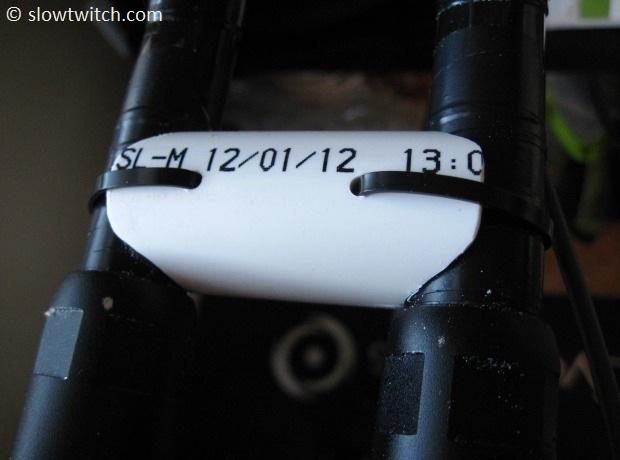
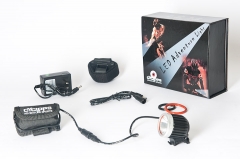
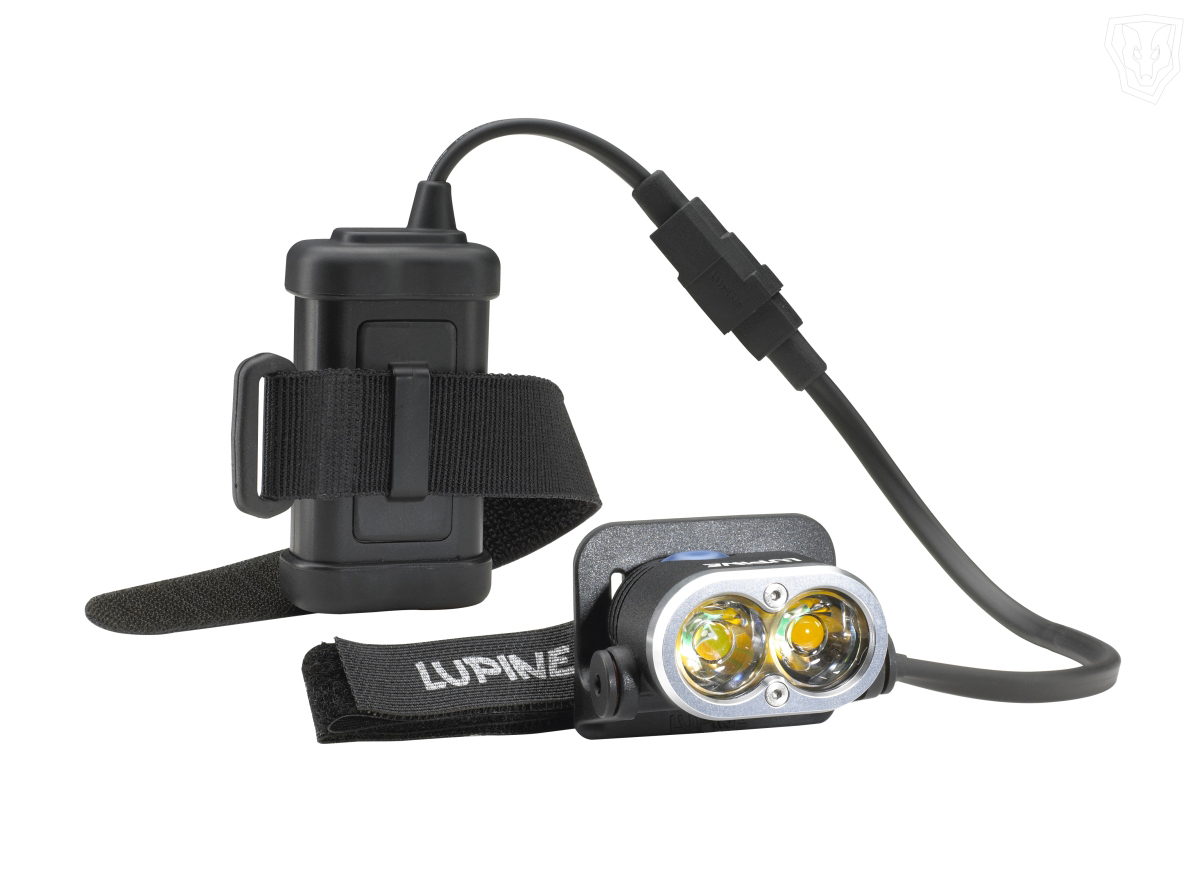

Start the discussion at forum.slowtwitch.com